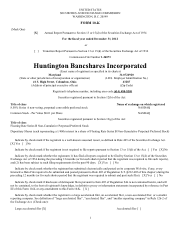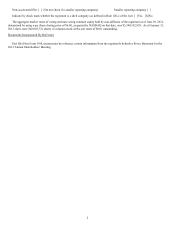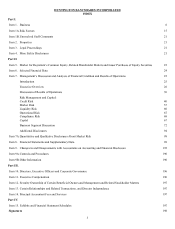Huntington National Bank 2012 Annual Report Download - page 19
Download and view the complete annual report
Please find page 19 of the 2012 Huntington National Bank annual report below. You can navigate through the pages in the report by either clicking on the pages listed below, or by using the keyword search tool below to find specific information within the annual report.11
Rules have been proposed to implement the Volcker Rule.
In October 2011, the Federal Reserve issued proposed rules to implement the “Volcker Rule” required by the Dodd-Frank Act.
The Volcker Rule prohibits an insured depository institution and its affiliates from: (i) engaging in “proprietary trading” and (ii)
investing in or sponsoring certain types of funds (“covered funds”) subject to certain limited exceptions. These prohibitions are
expected to impact the ability of U.S. banking organizations to provide investment management products and services that are
competitive with nonbanking firms generally and with non-U.S. banking organizations in overseas markets. The proposed rules would
also effectively prohibit short-term trading strategies by any U.S. banking organization if those strategies involve instruments other
than those specifically permitted for trading. We do not anticipate that impacts of the proposed rules will be material to our results of
operations or financial position.
The rules effecting debit card interchange fees under the Durbin Amendment, which became effective on October 1, 2011, have
negatively impacted our electronic banking income.
The Durbin Amendment required the Federal Reserve to establish a cap on the rate merchants pay banks for electronic clearing of
debit transactions (i.e. the interchange rate). The Federal Reserve issued final rules, effective October 1, 2011, for establishing
standards, including a cap, for debit card interchange fees and prohibiting network exclusivity arrangements and routing restrictions.
The final rule established standards for assessing whether debit card interchange fees received by debit card issuers were reasonable
and proportional to the costs incurred by issuers for electronic debit transactions. Under the final rule, the maximum permissible
interchange fee that an issuer may receive for an electronic debit transaction is the sum of 21 cents per transaction, a 1 cent fraud
prevention adjustment, and 5 basis points multiplied by the value of the transaction. As a result of implementing this lower debit card
interchange fee structure, our electronic banking income during 2012 was negatively impacted by over $55 million when compared to
2011.
There are restrictions on our ability to pay dividends.
Dividends from the Bank to the parent company are the primary source of funds for payment of dividends to our shareholders.
However, there are statutory limits on the amount of dividends that the Bank can pay to the holding company. Regulatory approval is
required prior to the declaration of any dividends in an amount greater than its undivided profits or if the total of all dividends declared
in a calendar year would exceed the total of its net income for the year combined with its retained net income for the two preceding
years, less any required transfers to surplus or common stock. As a result of the deficit position of its undivided profits, for the year
ended December 31, 2012, the Bank could not have declared and paid any cash dividends to the parent company without regulatory
approval.
Since the first quarter of 2008, the Bank has requested and received OCC approval each quarter for a capital reduction to enable
payment of periodic dividends to shareholders outside the Bank’s consolidated group on preferred and common stock of its REIT and
capital financing subsidiaries. A wholly-owned nonbank subsidiary of the parent company owns a portion of the preferred shares of
the REIT and capital financing subsidiaries. With the exception of the REIT and capital financing subsidiary dividends, we do not
anticipate that the Bank will declare dividends to the holding company during 2013.
If, in the opinion of the applicable regulatory authority, a bank under its jurisdiction is engaged in, or is about to engage in, an
unsafe or unsound practice, such authority may require, after notice and hearing, that such bank cease and desist from such practice.
Depending on the financial condition of the Bank, the applicable regulatory authority might deem us to be engaged in an unsafe or
unsound practice if the Bank were to pay dividends. The Federal Reserve and the OCC have issued policy statements that provide that
insured banks and bank holding companies should generally only pay dividends out of current operating earnings. Additionally, the
Federal Reserve may prohibit bank holding companies from making any capital distributions, including payment of preferred and
common dividends, if the Federal Reserve objects to the annual capital plan.
We are subject to the current capital requirements mandated by the Federal Reserve.
The Federal Reserve sets risk-based capital ratio and leverage ratio guidelines for bank holding companies. Under the guidelines
and related policies, bank holding companies must maintain capital sufficient to meet both a risk-based asset ratio test and a leverage
ratio test on a consolidated basis. The risk-based ratio is determined by allocating assets and specified off-balance sheet commitments
into four weighted categories, with higher weighting assigned to categories perceived as representing greater risk. The risk-based ratio
represents total capital divided by total risk-weighted assets. The leverage ratio is core capital divided by total assets adjusted as
specified in the guidelines. The Bank is subject to substantially similar capital requirements. Banking regulators are finalizing
changes to capital requirements that are expected to incorporate many of the Basel III capital requirements.
Generally, under the currently applicable guidelines, a financial institution's capital is divided into two tiers. Institutions that must
incorporate market risk exposure into their risk-based capital requirements may also have a third tier of capital in the form of restricted
short-term subordinated debt. These tiers are:
























